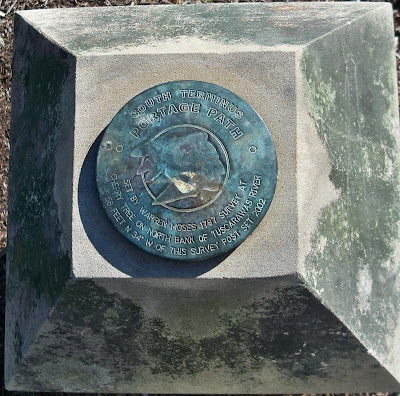
The north Indian is between the Cuyahoga river, the intersection of two roads, and a railroad.
In 2003 a monument trail was completed. Three foot bronze statues of fifty flint arrowheads with an Indian profile completed the path to twin statues by the Onondaga-Seneca artist Peter Jones.
 a home owner has an Indian in the front yard, also a bear
a home owner has an Indian in the front yard, also a bear  This statue was cast in 1905, and has received a new pedestal. He is on the intersection with West Market (Route 18). In the past years he was disturbed at Hallowe'en. His right hand had held an arrow at times. In Akron he is called
This statue was cast in 1905, and has received a new pedestal. He is on the intersection with West Market (Route 18). In the past years he was disturbed at Hallowe'en. His right hand had held an arrow at times. In Akron he is called
'Unk'.
At the time of American Independence the chief of the Wolf Clan of the Delaware's name was privately Konieschquanoheel, publicly Hopocan (Tobacco Pipe), the English speaking called him Captain Pipe *1725/1740?, 1794/1818?†. He enters the historical record at Fort Pitt in 1759, allied with the British against the French. During the next war he wished neutrality. The American side massacred his people in 1778, and much of his immediate family. He and other chiefs signed the first treaty with the Continental Congress. The rebel American forces proved bad allies. The Delawares (Lenape) continued a forced westward movement. The Delawares were a divided people, some allied with the British, some with the Americans, and some were pacifist Christians amongst the Moravians. On 19 April 1781 the main village of Coshocton was destroyed by Americans. Continued pressure would remove the Indians from Ohio.
 Rotaynah is Peter Toth's second Akron wooden Indian. The first one, that he made was in nearby Sand Run Park. It was destroyed through vandalism. Toth has carved at least one in each of the fifty states. The first one was in stone on the beach at La Jolla California (Romney has a beach house in La Jolla). The rest all in wood, the first being the ill fated one in Akron. This one is also on Rte. 18, west of the bronze statue.
Rotaynah is Peter Toth's second Akron wooden Indian. The first one, that he made was in nearby Sand Run Park. It was destroyed through vandalism. Toth has carved at least one in each of the fifty states. The first one was in stone on the beach at La Jolla California (Romney has a beach house in La Jolla). The rest all in wood, the first being the ill fated one in Akron. This one is also on Rte. 18, west of the bronze statue. the southern terminus marker is behind the Indian, a very few feet behind the statue
the southern terminus marker is behind the Indian, a very few feet behind the statue
Barberton's Hopocan

No comments:
Post a Comment